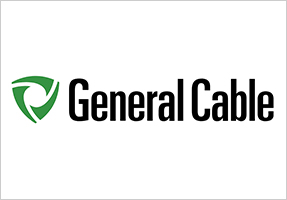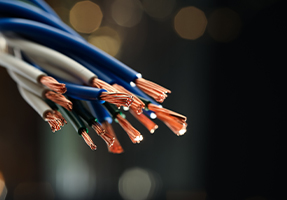Ampacity: Choosing Cable When The Heat Is On
- Melissa Westfall
- Wire & Cable
- Jun 19, 2019
- 27249views

Ampacity: Choosing Cable When The Heat Is On
Original Content Written By: Sam Friedman, Director, Technical Services, Carol® Brand Cord Products, General Cable
Thanks to the dedication and ingenuity of cable engineers around the world, there are cables available for an almost infinite number of applications.
Welding cable, extension cords, stage lighting cable, landscape lighting wire, diesel locomotive cable, major appliance cord — you name the energy transmission need, and I’ll name the applicable product.
Whether your project faces environmental extremes, necessitates considerable flexibility, or simply requires unfailing reliability and longevity, it’s essential that your quest for the optimal cable begins with identifying its optimal ampacity.
Ampacity is the maximum current an insulated conductor can safely carry without exceeding its insulation and jacket temperature limitations — or in plain terms, it’s a cable’s electric current-carrying capacity.
Most power cable is sized according to its ampacity, a fact that underscores the importance of first considering amperage needs when selecting portable power cable.
By doing so, you’ll avoid serious safety hazards, equipment damage and production downtime caused by overcurrent — i.e., too much current flowing through a conductor — which is a significant threat to under-amped cable.
Excessive current can cause overheating, insulation damage and fire/ shock hazards that, in turn, can harm equipment through heat buildup and produce cable faults that lead to lost productivity.
Therefore, it is essential to start every project with the correct cable and then have every installation reviewed and carried out by a trained electrical professional.
There are several systems of codes and standards that can help identify the correct ampacity for your power cable needs. Developed to provide direction for both trained professionals and end users, these codes set the foundation for the design and inspection of electrical installations.
First, there is the National Electric Code (NEC or NFPA 70), which catalogs the requirements for safe electrical installations and represents the primary document for guidance in the United States.
There are also regulations set forth by the Insulated Cable Engineers Association (ICEA) and the Institute of Electrical and Electronics Engineers (IEEE) — both of which address ampacity standards for power cables.
Because there are so many diverse electrical specialties, be sure to select a professional who has expertise in your particular application and its specific code requirements.
For the purpose of this discussion, let’s focus on the standards established by the National Electric Code. It’s amazing how many sections of the NEC deal with wire, depending on the user’s particular application.
It is essential for project safety that you study the portion of the code that concentrates on your intended environment and use.
As I mentioned earlier, temperature plays an important role in determining cable ampacity. For purposes of design rating, the ambient temperature is set at the maximum expected ambient temperature.
In the NEC, the values in the ampacity tables are based on 30°C ambient. In order to determine ampacities at ambient temperatures other than 30°C, the code has included correction factors for these other temperatures in the ampacity tables in Article 310.
Cable ampacity of a single conductor is calculated based on the size of the electrified conductor, the established ambient temperature and the temperature rating of the insulation and jacket compounds.
An increase in temperature rating of the compounds and/or an increase in conductor size will increase cable ampacity. Conversely, an increase in ambient temperature will decrease ampacity.
However, the number of current-carrying conductors found in a cable also affects ampacity. When a group of cables is bunched closely together, the NEC requires a derating of the ampacity for each individual cable.
This is because tightly gathered cables can create a significant buildup of heat, which could rise above the rated temperature of the compounds used. This bunching effect also hinders heat dissipation, further increasing the risk of heat-related cable damage.
Refer to NEC Table 310.15(B)(2)(a) for specifics about ampacity derating based on the number of cables used in cable, conduit or raceway.
It is important to remember that heat degrades most ordinary insulating materials, and this decay directly affects cable ampacity — yet another reason to take current-carrying capacity into account when selecting a cable.
By doing so, you confirm that the conductor’s insulating material and jacket can handle the heat load caused by electrical current flow and eliminate the possibility of exposing cables to temperatures higher than they are designed to manage.
The NEC also permits ampacities to be calculated. However, this should only be attempted under engineering supervision and when the parameters of the cable and installation are known. Article 310.15(C) provides the method for doing this calculation.
There are some specific cabling applications for which the NEC does not set ampacity guidelines, including mining cable and utility cable. For example, most ampacity ratings for mining cable come from ICEA standard tables, which assume an ambient temperature of 40°C vs. 30°C.
Because of its many specialized applications, the ampacity ratings for most power generation and energy transmission/distribution utility cables are specified by use — such as direct-buried cable, suspended cable (e.g., transmission lines) and in-duct cable. These particular installations also require specific engineering calculations that incorporate factors like temperature, wind speeds, and sunlight exposure.
Understandably, such highly specialized setups require not only unique ampacity guidelines but also engineering supervision and the seasoned judgment of a trained electrical professional.
So, the next time you’re in the market for a cable solution, start your search by first establishing the project’s ampacity requirements.
By doing so, you can avoid dangerous heat buildup, prevent equipment damage and ensure the long-term safety of your cable selection. But don’t worry, you don’t have to go it alone!
The codes and standards established for your particular application can provide invaluable guidance throughout your product search and final installation.
If your project falls into one of the specialized setups addressed in a unique code section, please consider having your cable installation carried out under engineering supervision.
Put simply, safety depends on selecting the right cable. By paying attention to the current-carrying capacity of your chosen cable, you’ll help maximize the life of your cable and contribute to the well-being of anyone who comes into contact — be it directly or indirectly — with your installation. Now that’s a hot idea!






